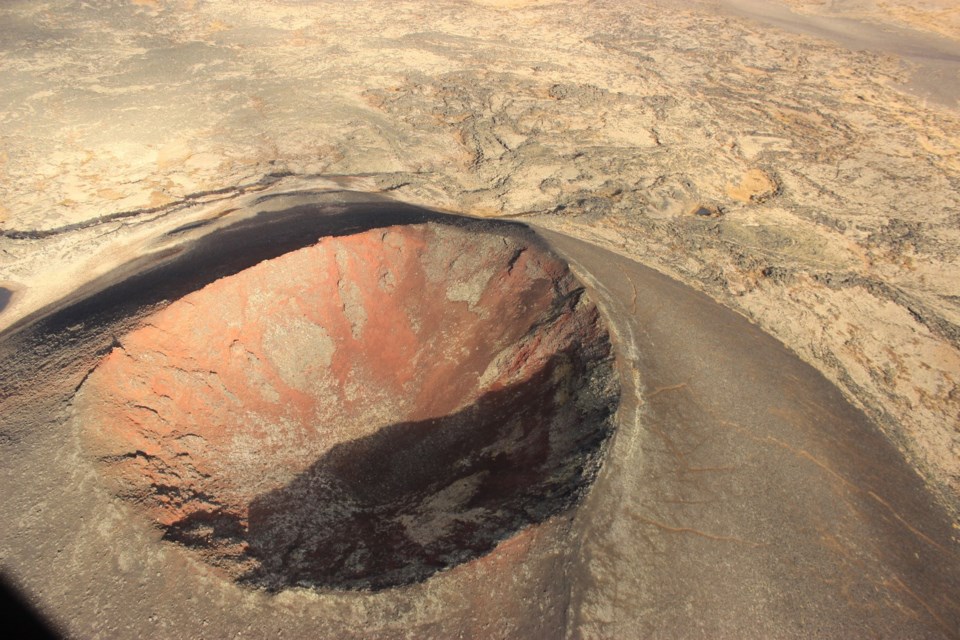B.C. is home to two major volcanic mountain ranges in its northwest corner. The Mt. Edziza and Spectrum ranges cover more than 2,000 square kilometres of ice-frosted peaks, valleys, glaciers, and canyons.
The Prince George Citizen's Mark Nielsen trekked across the surreal landscape of for a week and called it a worthwhile challenge.
But the landscape has much more to offer than just hiking. The largest known obsidian outcrops in Western Canada are found here, etched into the soil eight million years ago, a gift left behind by basalt strato-volcanoes, shield volcanoes, lava domes and calderas.
Mount Edziza itself is a strato-volcano, structured with steep sides and more cone-shaped than its shield-like brethren.
The volcanic complex at Edziza has long since gone quiet, as the last magma cycle was 20,000 years ago, the fifth and final of cycles characterized by constant eruptions.
The gift of obsidian has been used by First Nations in the region as early as 10,000 years ago, with the Tahltan people having used the volcanic glass to make tools and weaponry. Edziza means "cinders" in the Tahltan language.
One can’t help but wonder where those fragments travelled, and it’s been documented that Edziza obsidian was traded as far away as Alaska and Northern Alberta, during 10,000 years of prehistory. A fragment has even found in the Peace Region at the Tse'K'wa Cave, a 12,000 year gathering site for Treaty 8 First Nations.
That trade caught the attention of Simon Fraser University professor Knut Fladmark in 1984, penning the paper Mountain of glass: Archaeology of the Mount Edziza obsidian source. It was published in World Archaelogy, an international journal.
Fladmark spent much of his research time in two quarry areas dubbed Goat Mountain and Artifact Valley by Raspberry Creek. The Talhtan may not have been exclusive visitors to the region, he explains. Two archeology reconnaissance trips were taken in 1977 and 1981 to find the quarry sites.
“There is no certainty that the Tahltan have always been in sole or primary control of the obsidian source and the ethno-linguistic identity of all prehistoric users is only conjectural,” writes Fladmark.
“Other Athapaskans, or Pacific coastal peoples such as the Tlingit or Tsimshian, are among some of the more likely possibilities in late prehistory,” he adds.
The remote location is also convenient for archaeological research, noted Fladmark, as the complex has limited entry by road, with most opting to fly in.
“With the exception of occasional hikers, big-game hunting parties, and geological exploration crews, the region remains relatively unaffected and unknown by the outside modern world,” he explains, as the only practical access to the study area in 1984 was by helicopter or guided pack-train.
Access to Edziza remains just as limited today, accessible only in summer to early fall, with a trail from Telegraph Creek or again by helicopter.
Obsidian from Edziza tends to be green-black in colour, noted Fladmark, admiring the quality and variety of the stone.
“From a lithic craftsman's perspective, the bulk of Edziza obsidian is inherently high-quality glass, whatever its colour,” he writes.
Crafters were also more likely to have removed whatever materials they needed, finishing their tools and weapons elsewhere, rather than staying at an open site, notes Fladmark. The rough terrain and limited seasonal access made this necessary.
“Even under current conditions, aboriginal utilization of the 'Goat Mountain' obsidian source would be effectively limited to a maximum period of about three months,” Fladmark explains.
The two quarry sites cover over 32,000 square metres, and were packed with a carpet of 1,000 to 4,000 obsidian fragments items per metre. It's also worth noting that Fladmark is a legend in the field of archaelogy, teaching generations of students, advancing the field with cutting edge techniques and rigorous analyses, receiving a Smith-Wintemberg award in 2013 for his contributions.
Edziza continues to intrigue the public and academic minds, with Simon Fraser University associate professor Rudy Reimer producing a 2015 paper titled Reassessing the role of Mount Edziza obsidian in northwestern North America.
Reimer is a member of the 麻豆社国产First Nation and has produced several TV series for APTN and Life from Ash and Ice, a documentary on Edziza for the Knowledge Network.
“The Tahltan and their close relations likely exchanged Mount Edziza obsidian at key locations along the Skeena and Nass Rivers. Elsewhere at the Taku and Chilkat Rivers, other Athapaskan groups exchanged Mount Edziza obsidian with coastal groups,” writes Reimer, noting researchers should be diligent in determining relationships between lava flow sites and prehistoric obsidian trade.
Edziza has long been protected, both by its remote nature and by law, becoming Mount Edziza Provincial Park in 1972 to preserve the volcanic and cultural treasures unique to the northern BC range, protecting over 230,000 hectares of the Tahltan highlands.



